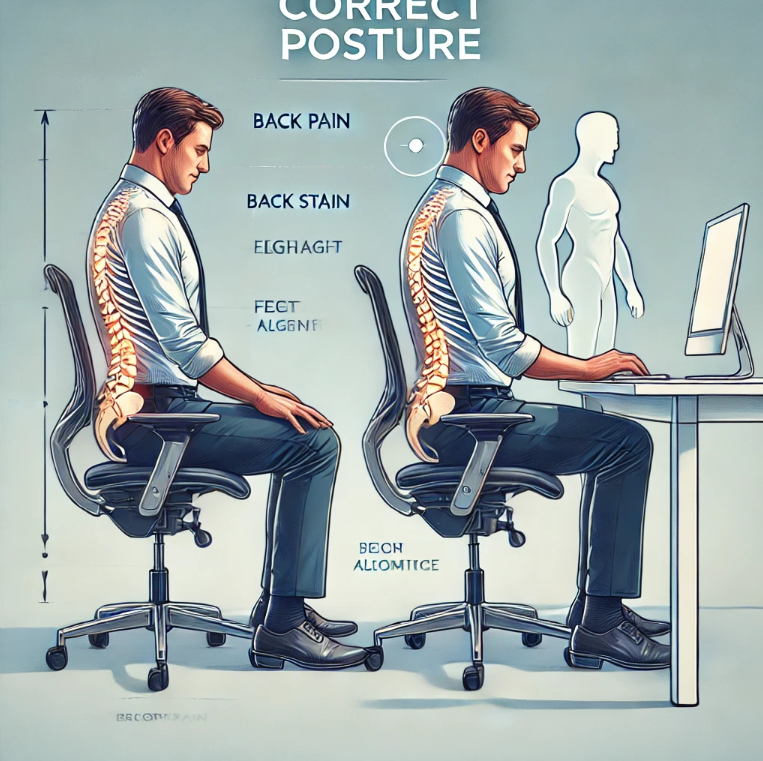Posture is often overlooked in our daily lives, yet it plays a crucial role in our overall health. Poor posture not only impacts your physical appearance but can also lead to chronic discomfort and long-term health issues. Back pain is one of the most common consequences of improper posture, affecting millions worldwide. In this blog, we will discuss why posture matters, how to address back pain caused by bad posture, and actionable steps to improve your alignment for good health.
Why Posture Matters
Posture refers to the position in which you hold your body while standing, sitting, or lying down. Proper alignment ensures that your body’s weight is evenly distributed, reducing stress on muscles, ligaments, and joints. On the other hand, bad posture can lead to muscle fatigue, joint strain, and even permanent deformities if left uncorrected.
Common Bad Posture Back Pain Symptoms:
- Persistent pain in the upper or lower back
- Tension in the neck and shoulders
- Fatigue during or after sitting or standing
- Limited flexibility and mobility
- Discomfort in the back, even during minimal physical activity
Correcting Posture Hurts Back – Why Does This Happen?
It’s not uncommon to feel discomfort when you start correcting your posture. This phenomenon is often discussed on forums like “correcting posture hurts back reddit,” where people share similar concerns. The reason behind this discomfort is that your muscles have adapted to improper posture over time. When you attempt to correct your alignment, underused muscles are activated, which can cause temporary soreness or pain. However, this is a sign that your body is adjusting to healthier habits.
How to Permanently Fix Posture
To permanently fix your posture, it’s essential to incorporate a mix of awareness, exercises, and ergonomic adjustments into your routine. Below are practical steps:
1. Understand Your Current Posture
Start by assessing your posture. Stand in front of a mirror and check the alignment of your ears, shoulders, hips, and knees. If they don’t form a straight line, you may have issues to address.
2. Adopt Good Sitting Habits
Many individuals suffer from poor posture while sitting for extended periods. Here are tips on how to have good posture when sitting:
- Sit with your back straight and shoulders relaxed.
- Keep both feet flat on the floor.
- Use a chair with lumbar support to maintain the natural curve of your spine.
- Avoid slouching or leaning forward for long periods.
3. Focus on Standing Posture
Standing for extended periods with poor posture can lead to bad posture back pain symptoms. To stand correctly:
- Keep your weight evenly distributed on both feet.
- Align your head over your shoulders and your shoulders over your hips.
- Avoid locking your knees.
4. Strengthen Your Core and Back Muscles
Strong core and back muscles are essential for good posture. Exercises like planks, bridges, and yoga poses can help build strength and improve alignment.
Exercise Routine Table for Posture Improvement:
| Exercise | Target Area | Repetitions/Time |
|---|---|---|
| Plank | Core and shoulders | 3 sets of 30 seconds |
| Cat-Cow Stretch | Spine flexibility | 10 repetitions |
| Shoulder Rolls | Upper back and shoulders | 10 repetitions each direction |
| Wall Angels | Upper back and shoulders | 3 sets of 10 |
| Glute Bridges | Lower back and glutes | 3 sets of 15 |
5. Use Ergonomic Tools
Invest in ergonomic furniture such as adjustable chairs, standing desks, and supportive pillows. These tools help maintain proper posture, especially during long working hours.
6. Stretch Regularly
Stretching helps relieve tension caused by prolonged poor posture. Focus on areas like the neck, shoulders, and upper back to alleviate upper back pain from poor posture.
7. Seek Professional Guidance
If your posture issues are severe, consider consulting a physiotherapist or chiropractor. They can provide tailored advice and treatments to fix bad posture back pain location.

Common Bad Posture Back Pain Locations
Poor posture can affect various parts of your back, including:
| Location | Common Causes | Symptoms |
| Upper Back | Hunched shoulders, forward head tilt | Stiffness, tension, or pain |
| Lower Back | Slouching, sitting improperly | Dull ache, sharp pain during movement |
| Neck | Text neck from looking at screens | Headaches, neck stiffness |
How to Improve Posture for Women
Women often face unique posture challenges due to factors like pregnancy, hormonal changes, or wearing high heels. Here are tips specifically for women:
- Avoid prolonged high heel use: Opt for comfortable, flat footwear to reduce stress on your lower back.
- Strengthen pelvic muscles: Exercises like pelvic tilts can help maintain spinal alignment.
- Use supportive bras: Proper support reduces strain on the upper back.
- Practice yoga or Pilates: These activities improve flexibility, core strength, and balance.
FAQs About Posture and Back Pain
1. Does correcting posture hurt back?
Yes, it can initially cause discomfort as your body adjusts to proper alignment. This pain is temporary and indicates that your muscles are strengthening.
2. How to permanently fix posture?
Incorporate a combination of strengthening exercises, ergonomic adjustments, and mindfulness into your daily routine.
3. Is correcting posture hurts back Reddit advice reliable?
While Reddit forums offer personal experiences, it’s essential to rely on expert advice from healthcare professionals for safe and effective solutions.
4. What are bad posture back pain symptoms?
Symptoms include stiffness, muscle fatigue, and localized pain in areas like the neck, shoulders, and lower back.
5. How to have good posture when sitting?
Use a chair with lumbar support, keep your feet flat on the ground, and avoid slouching.
6. Where is bad posture back pain location?
Pain can occur in the upper back, lower back, or neck, depending on the type of poor posture.
7. Can upper back pain from poor posture be treated?
Yes, through targeted exercises, stretching, and ergonomic adjustments, you can alleviate upper back pain.
8. How to improve posture women-specific tips?
Focus on pelvic exercises, avoid prolonged high heel use, and practice yoga or Pilates.


